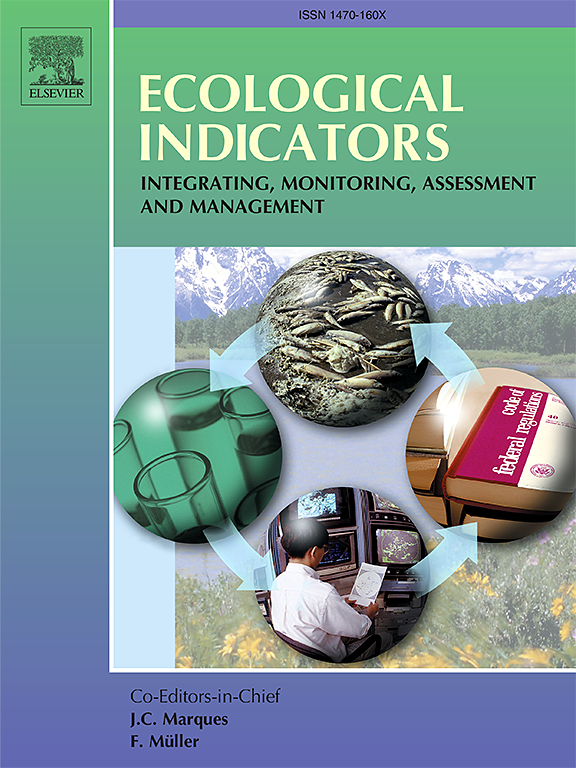Ecological risk assessment and source identification of heavy metals in the sediments of the Danjiang River Basin: A quantitative method combining multivariate analysis and the APCS-MLR model
IF 7
2区 环境科学与生态学
Q1 ENVIRONMENTAL SCIENCES
引用次数: 0
Abstract
The heavy metal content in river sediment is a sensitive indicator of pollution in aquatic ecosystems and plays a key role in understanding the risks, characteristics, and sources of heavy metal pollution in a region. This study combined traditional assessment methods with the Nemerow integrated risk index (NIRI), which is improved based on the potential ecological risk index (RI) and the Nemerow integrated pollution index (NIPI), to evaluate the pollution level of sediment in the Danjiang River. Based on principal component analysis (PCA), the absolute principal component score-multiple linear regression (APCS-MLR) model was employed to analyze the contribution of pollution sources. The study results showed that the average concentrations of most heavy metals exceeded their corresponding background values, and the distribution of heavy metal content was significantly influenced by human activities. The degree of pollution varied among the sampling sites, and the results of NIRI on the spatial distribution and severity of contamination are generally consistent with other assessment indicators, providing a more detailed and comprehensive delineation. The results of the multivariate statistical analysis indicate that Cu, Zn, Pb, and As mainly originated from natural sources, Cd and Ni primarily came from mixed sources such as agriculture and mining, while Cr was mainly associated with industrial activities. The APCS-MLR model results further confirm with high confidence that the sources of heavy metals in the sediments of the study area are complex, predominantly influenced by natural processes such as weathering and erosion. As the water source for the Middle Route of the South-to-North Water Diversion Project, the safety of the Danjiang River’s aquatic ecosystem is crucial for the health of nearly 100 million people in China. These findings provide an important foundation for Danjiang River water resource protection and offer a reference for ecological security and pollution prevention in other rivers.

丹江流域沉积物中重金属生态风险评价及来源识别——多变量分析与APCS-MLR模型相结合的定量方法
河流沉积物中的重金属含量是水生生态系统污染的敏感指标,对了解一个地区重金属污染的风险、特征和来源起着关键作用。本研究将传统的评估方法与基于潜在生态风险指数(RI)和内梅罗综合污染指数(NIPI)改进的内梅罗综合风险指数(NIRI)相结合,对丹江泥沙的污染程度进行了评估。在主成分分析(PCA)的基础上,采用绝对主成分得分-多元线性回归(APCS-MLR)模型分析污染源的贡献率。研究结果表明,大部分重金属的平均浓度超过了相应的背景值,重金属含量的分布受人类活动的影响较大。各采样点的污染程度不尽相同,近红外成像对污染空间分布和严重程度的分析结果与其他评估指标基本一致,提供了更详细、更全面的划分。多元统计分析结果表明,铜、锌、铅和砷主要来源于自然界,镉和镍主要来源于农业和矿业等混合污染源,而铬主要与工业活动有关。APCS-MLR 模型的结果进一步证实,研究区域沉积物中重金属的来源十分复杂,主要受风化和侵蚀等自然过程的影响。作为南水北调中线工程的水源地,丹江水生生态系统的安全关系到中国近亿人口的健康。这些研究成果为丹江水资源保护提供了重要依据,也为其他河流的生态安全和污染防治提供了参考。
本文章由计算机程序翻译,如有差异,请以英文原文为准。
求助全文
约1分钟内获得全文
求助全文
来源期刊

Ecological Indicators
环境科学-环境科学
CiteScore
11.80
自引率
8.70%
发文量
1163
审稿时长
78 days
期刊介绍:
The ultimate aim of Ecological Indicators is to integrate the monitoring and assessment of ecological and environmental indicators with management practices. The journal provides a forum for the discussion of the applied scientific development and review of traditional indicator approaches as well as for theoretical, modelling and quantitative applications such as index development. Research into the following areas will be published.
• All aspects of ecological and environmental indicators and indices.
• New indicators, and new approaches and methods for indicator development, testing and use.
• Development and modelling of indices, e.g. application of indicator suites across multiple scales and resources.
• Analysis and research of resource, system- and scale-specific indicators.
• Methods for integration of social and other valuation metrics for the production of scientifically rigorous and politically-relevant assessments using indicator-based monitoring and assessment programs.
• How research indicators can be transformed into direct application for management purposes.
• Broader assessment objectives and methods, e.g. biodiversity, biological integrity, and sustainability, through the use of indicators.
• Resource-specific indicators such as landscape, agroecosystems, forests, wetlands, etc.
 求助内容:
求助内容: 应助结果提醒方式:
应助结果提醒方式:


